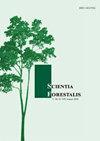种质库中有多少物种会改名?对安亨比试验站桉树种质库的研究及其实际意义
IF 0.4
4区 农林科学
Q4 FORESTRY
引用次数: 0
摘要
桉树是一种长周期作物,几十年来被引入巴西。巴西的种质库中有几个种群的植物学分类已经过时,因为这些分类多年来曾多次修改。本研究概述了巴西主要桉树种质库之一的安亨比森林科学实验站(ESALQ/USP)中分类过时的物种,并讨论了对使用这些种质的育种计划可能产生的影响。在这次调查中,我们发现有记录表明,巴西引进了 20 个桉树品种的种群。不过,根据最新更新的植物学分类,这一数字已经增加,安亨比种质库在对几个物种进行重新分类后,目前有 22 个物种。此外,一个重大变化是将一些物种从桉树属重新分类为伞形科。一个最初引入的物种,即 Eucalyptus maculata,现在被认为是(根据最初的产地)Corymbia maculata 和 C. variegata。E. pellita,而 E. scias 在澳大利亚新南威尔士州的南部分布较少。同样,引进的 E. phaeotricha 现在一般被认为是 E. tindaliae,而引进的 E. resinifera 现在被认为是 E. macta(根据引进的原产地)。在某些情况下,由于缺乏详细的研究,无法对引进的同名物种进行木材生产力、耐受性和/或性状方面的比较,从而加剧了物种分类的混乱。本文章由计算机程序翻译,如有差异,请以英文原文为准。
How many species change names in a germplasm bank? Study of the Anhembi Experimental Station eucalypt germplasm bank and practical implications
Eucalypts are a long-cycle crop that have been introduced in Brazil during several decades. The germplasm banks of the country make available several populations whose botanical classifications are somewhat outdated since these classifications have been subject to several modifications over the years. This study outlines a review of species with outdated classifications in the Anhembi Experimental Station of Forest Sciences (ESALQ/USP), one of Brazil’s main eucalypt germplasm banks and discusses the possible implications for the breeding programs that use said germplasm. In this survey, we found records that indicate introductions were made of populations of 20 eucalypts species. However, this number has increased according to the most recent update of botanical classifications, and the Anhembi Germplasm Bank has currently 22 species after a few species were reclassified. Furthermore, a major change has been the reclassification of some species from the genus Eucalyptus to the genus Corymbia. One original introduction, Eucalyptus maculata, is now considered to be (according to original provenances), Corymbia maculata and C. variegata . One species originally introduced as E. pellita has been renamed E. scias ; E. pellita still exists in north Queensland, Australia and Papua New Guinea, while E. scias has a much smaller southerly distribution in New South Wales, Australia. Similarly, an introduction of E. phaeotricha is now generally considered to be E. tindaliae, and an introduction of E. resinifera is now considered to be E. macta (according to the provenance area of the introduction). The confusing classification of the species is aggravated, in some cases, by the lack of detailed studies that allow comparing the species introduced with the same name, regarding wood productivity, tolerance and/or traits that are fundamental for defining the species to be introduced or worked on by the breeding programs.
求助全文
通过发布文献求助,成功后即可免费获取论文全文。
去求助
来源期刊

Scientia Forestalis
Agricultural and Biological Sciences-Forestry
CiteScore
1.00
自引率
0.00%
发文量
39
期刊介绍:
Scientia Forestalis is a scientific publication of the IPEF – Institute of Forest Research and Studies, founded in 1968, as a nonprofit institution, in agreement with the LCF – Department of Forest Sciences of the ESALQ – Luiz de Queiroz College of Agriculture of the USP – São Paulo University. Scientia Forestalis, affiliated to the ABEC – Brazilian Association of Scientific Publishers, publishes four issues per year of original papers related to the several fields of the Forest Sciences.
The Editorial Board is composed by the Editor, the Scientific Editors (evaluating the manuscript), and the Associated Editors (helping on the decision of acceptation or not of the manuscript, analyzed by the Peer-Reviewers.
 求助内容:
求助内容: 应助结果提醒方式:
应助结果提醒方式:


